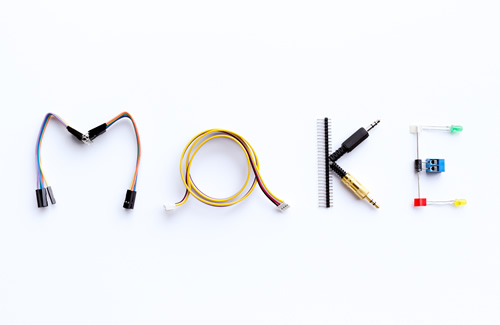As an elementary educator for most of my career, I’ve had the privilege of working with a variety of learners—from inner-city students in North Carolina to university-level students in Chicago—but I found my true calling as the librarian at Hubbard Woods Elementary in Winnetka, Illinois. I’ve been called the “Willy Wonka of school librarians” because I transformed our traditional library into what I call an IDEA (Innovation, Design, Engineering, and Art) Lab complete with flexible furniture, robotics, engineering tools, iPads, laptops, and sewing machines.
To get started, I used my experience as a classroom educator to create a cross-curricular library curriculum that supports classroom teachers’ lessons, marrying the idea of books and bytes. Daily activities include robot bowling, using robots to paint pictures, and filming and producing music videos staring (you guessed it) robots!
Related content: How to transform a library into a makerspace
For other districts that want to turn their libraries into IDEA labs, here are some insights into how we made it all happen.
4 steps to turning your space into a 21st-century library
1. Create a dream binder. In 2015, I received a lump sum of funding to help transform our traditional library into a flexible, collaborative makerspace. One of the conditions of the funding was that we needed to spend it in a certain amount of time, so we had four to five months to make some big decisions.
Related Content:
eSchool News STEM, STEAM, & Makerspaces Guide
The eSchool News STEM, STEAM, & Makerspaces Guide is here! It features strategies to help you integrate STEM, STEAM, and makerspace education into classrooms, and it offers a look at how these tools engage students and give them valuable skills. A new eSchool News Guide will launch each month–don’t miss a single one!
Luckily, when the PTO asked what I needed to create the space, I pulled out a three-ring binder of photos, drawings, and ideas I collected during my first few years as a librarian. I had been searching the Internet and library magazines for inspiration.
The binder was ready before we started, and that helped my PTO realize that my dream was a good dream and they wanted to support it. Using pictures of furniture and spaces was a great way for me to communicate my ideas and make them come to life.
2. Ask a lot of questions—and really listen to the answers. During the process of building our makerspace, a group of parents and teachers visited schools all over Illinois, Wisconsin, and Colorado to see their spaces. We asked librarians and teachers thoughtful questions about which tools they liked the most and which ones they could live without.
At every school we visited, someone said, “If we could do something different, when we were first starting out we would not have gotten a 3D printer and instead put that $3,000 into XYZ.”
Because of that feedback, we didn’t put a lot of money into 3D printers until later on.
3. Do all that you can to help educators see the cross-curricular value. I love to incorporate coding and robotics into my library, and the kids love it too. One of my favorite tools to introduce our youngest students to the world of coding is KIBO by KinderLab Robotics. Students link wooden blocks to create code, then use the robot to scan the blocks and make it go. It’s a good, device-free way for students to learn about coding and robotics.
Part of my role is to help classroom educators see the cross-curricular value of coding and robotics. A big part of the first-grade curriculum is learning about our community. To support the classroom during library time, the students and I created a Lego city and used KIBO to navigate around to the major landmarks. Students thoroughly enjoyed the activity, and the classroom teacher saw the connection that robotics has to the curriculum.
4. Incorporate digital and physical tools. We have a wide variety of engineering tools and materials that I use alongside traditional robots to encourage students to prototype solutions to problems. One of my favorites is Rigamajig, a collection of wooden planks, wheels, and pulleys that connect easily with heavy-duty plastic wing nuts and bolts. The kids can prototype and build large things like cars, chairs, and benches quickly and easily. With the simple machine add-ons, we’ve been able to introduce complex concepts like cams, cogs, and pulleys in ways that kids can physically understand.
Although some people think cardboard boxes and sewing machines are non-traditional makerspace tools, I strongly disagree. We believe in having students learn valuable skills and appreciate the process as much as the final product. To that end, we have emphasized both hand- and machine-sewing in our K–4 progression. It’s exciting to see them gain confidence and skill.
We have a massive Lego wall and tons of cardboard, cardboard tools, and hand tools. We know that saws and drills can hurt children, but why keep a good tool away from them when you can teach them how to use it safely and it makes the work easier?
One of my idols, Gever Tulley, said, “Children can build anything, and by building anything, learn anything.”
Our IDEA Lab is a balance of high- and low-tech tools that encourages students to explore leaning in a whole new light. Hanging in our IDEA Lab is a giant light bulb that I found online from a thrift shop in Paris. It glows the words “IDEA Lab” in our space, which is symbolic of the passion kids have for learning about the world. I’m lucky that I get to have a space to help kids explore the things that will “light up” their own metaphorical light bulbs!
- Science teachers, math teachers, history teachers–we’re all reading teachers now - December 20, 2024
- Using AI to teach persuasive writing to English learners - December 20, 2024
- Information literacy is key in the age of AI - December 19, 2024



